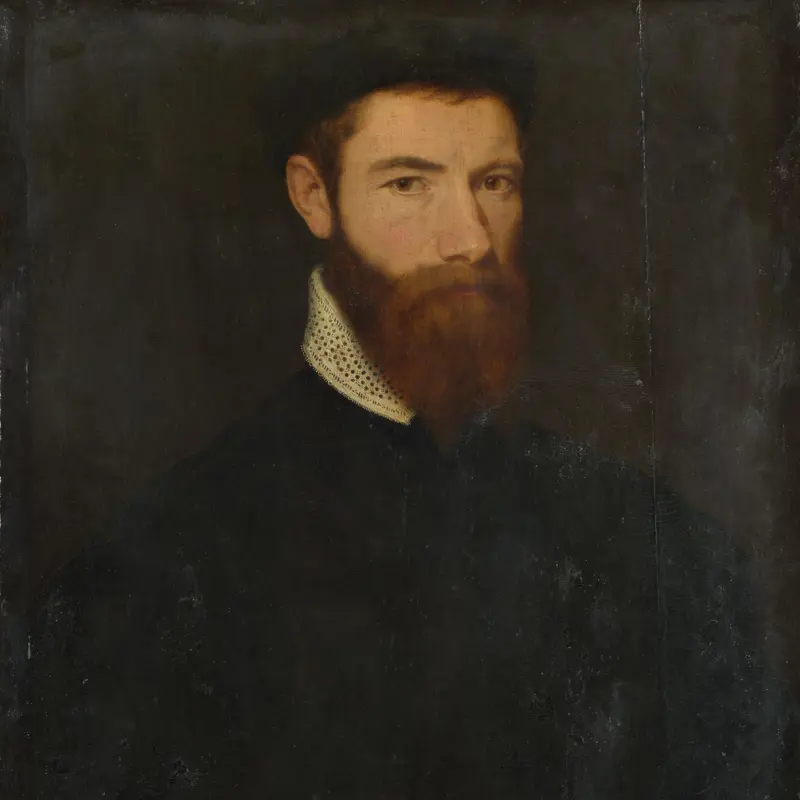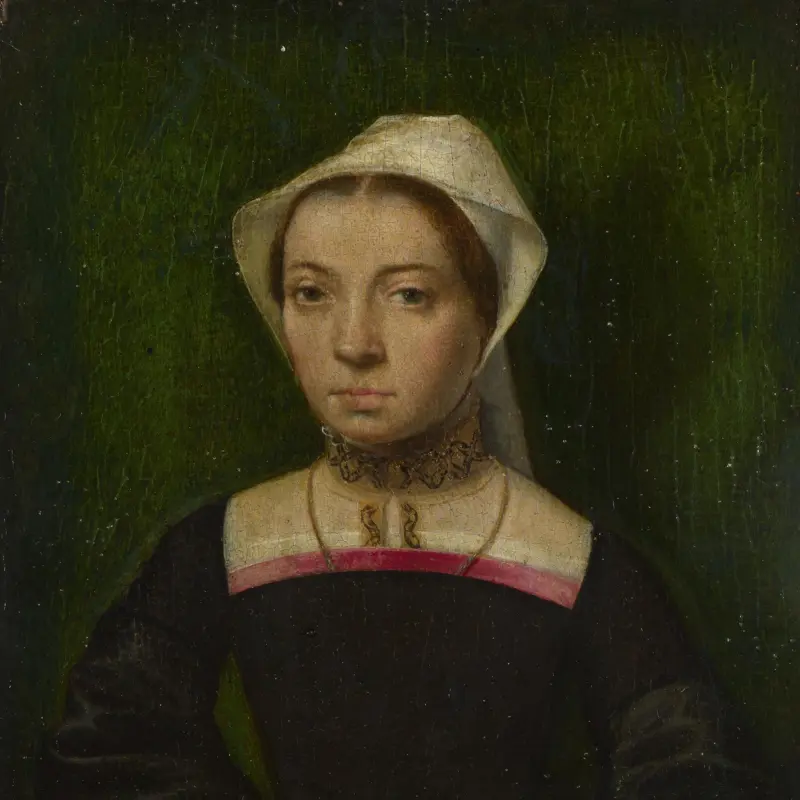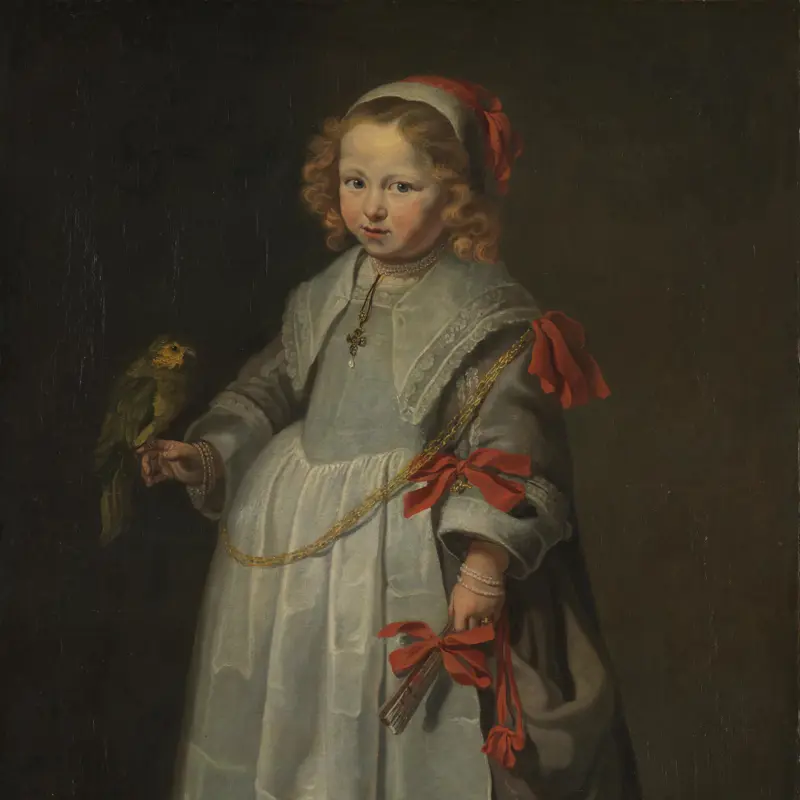The identity of the artist responsible for this impressive panel is a mystery. In fact, whether the painter was Netherlandish or French is up for debate. The overall sense of plasticity, monumentality and the strong shadows recall the work of French painters like Jean Hey. On the other hand, the composition and versatile execution – alternating smoothly painted areas and minute details with more dynamic passages – pay homage to the Netherlandish tradition of Jan van Eyck (The Virgin and Child with the Canon Joris van der Paele; Bruges, Groeningemuseum) and Hugo van der Goes (The Portinari Altarpiece; Florence, Galleria degli Uffizi). The Netherlandish hypothesis is supported by the painting’s Baltic oak panel, since French artists tended to use locally sourced oak.
Stylistic parallels can be found with the early work of Jan Gossaert. The dramatically foreshortened faces of the saints and angels are reminiscent of some of his early drawings, for instance the left saint of The Holy Family with Saints (c. 1510-5; Albertina, Vienna). The treatment of the brocade and metalwork compares well with passages from Gossaert’s Adoration of the Kings (London, National Gallery). Both artists also used similar underdrawing techniques, especially the way of sketching the ocular cavities, the knuckles, the shading of the Virgin’s forehead, and the absence of wash. The eccentricity that pervades the panel also recalls Gossaert’s manner. However, the facture of The Virgin and Child with Saints Louis and Margaret and Two Angels is generally less crisp, and no definitive conclusions can be drawn from these observations. This painting challenges art historians’ tendency to focus on names and demonstrates that for the late medieval and Renaissance periods, anonymity can intersect with extraordinary quality.
At the centre of an open-air chapel, the Virgin and Child sit enthroned before a richly embroidered cloth of honour. They are flanked by the canonised King of France Saint Louis; he is clad in blue robes embroidered with the fleur-de-lis and wears the collar of the French royal order of Saint Michael. His individualised features suggest it is a portrait. Opposite is Saint Margaret, sumptuously dressed and rising unharmed from the broken carapace of the frowning, slobbering dragon she defeated. Completing the circle are two angels: one plays a mouth harp while the other holds a song book, inscribed with an identifiable Marian hymn, ‘Ave Regina Caelorum, Mater regis angelorum’. The musical notations, however, are fanciful.
If the subject of the Virgin enthroned with angels and saints was nothing new by first decade of the 16th century, its treatment here is wildly inventive; the painting is replete with iconographic oddities. These include the bare wooden steps upon which the Virgin’s throne is set; they stand out dramatically in this splendid setting. The plain timber was probably a symbol of humility, but, secured with prominent nails, it also potently evokes the wood of the cross and Christ’s impending sacrifice. No other example of such imagery is known to survive. Similarly, the squirming figures topping Saint Louis’s sceptre (possibly a Last Judgment) are eccentric for metalwork of the period. The sequined net that adorns Margaret’s braided hair is also unusual, as are her crown of daisies (marguerites in French) and the dove resting on her shoulder – an allusion to a little-known passage from The Golden Legend recounting Margaret’s miraculous crowning by a bird descended from heaven. The angel playing the mouth harp – a sound hardly associated with celestial harmony – is a rare occurrence in medieval iconography. The historiated capitals that top the pilasters behind the holy figures alternate recognisable episodes from the Old Testament (The Drunkenness of Noah, The Grapes of Canaan, Adam and Eve, and Cain and Abel) with more obscure and even surprisingly bawdy subjects (for instance the unruly putto showing us his behind at top right).
Seen from below, the figures have been brought to the very edge of the picture plane, lending them great monumentality. This tightly cropped format is original: the panel shows unpainted edges on all its sides. The painter’s ambition to dazzle viewers permeates every inch of the painting, evident in details such as the twisting chain of Margaret’s girdle, the translucent gems of her cross, the loose strand of hair across the Virgin’s chest, or the sliver of light that catches her right cheek.
Examination of the panel via dendrochronology indicates that the painting was executed after 1483. On the other hand, the design of the chain of the Order of Saint Michael worn by Saint Louis, with its double knots or aiguillettes, was modified by Francis I in 1516, implying that the picture was painted before that year. A dating of about 1510 seems appropriate on stylistic grounds.
The painting was first documented in 1602 in the urban priory of the Premonstratensian Abbey of Drongen (Tronchiennes) in Ghent, when the figures of Saints Louis and Margaret were drawn by the painter Antonio de Succa on the mistaken assumption that they were royal portraits. Whether the priory was the painting’s original location is unknown, but the choice of saints would not be inappropriate. The Premonstratensians had particular reverence for Saint Louis because he had granted them the right to bear the fleur-de-lis in their coat-of-arms. In 1608, the monks consecrated an altar devoted to the Virgin and Saint Margaret at the Ghent priory, perhaps reflecting pre-existing devotional interests. The swan, which appears among the grotesque ornaments on the right pilaster, was the main feature of the monastery’s arms.



